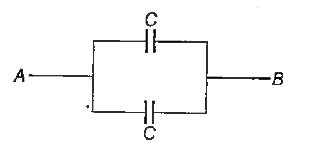Two identical capacitors are first joined in parallel and then in series. Find the ratio of their equivalent capacitances.
There are two cases as follows:
case 1 Two identical capacitors are joined in parallel

The equivalent capacitance CAB=C+C⇒CAB=2C
case II Two identical capacitors are joined in series

The equivalent capacitance CPQ=C.CC+C=C2
Hence, CABCPQ=2C(C/2)=4
Similar Questions
Knowledge Check
- Question 1 - Select One
Two identical capacitors are first connected in series and then in parallel. The ratio of equivalent capacitance is
A1:1B1:2C1:3D1:4 - Question 2 - Select One
Two equal capacitors are first connected in series and then in parallel. The ratio of the equivalent capacities in the two cases will be:
A4:1B2:1C1:4D1:2 - Question 3 - Select One
Three capacitors each of capacity C are first joined in parallel and then in series. It is found that the difference in their effective capacities when joined in parallel and series respectively is 16μF. What is the capacitance of each capacitor?
A3μFB4μFC5μFD6μF
Three capacitors of capacitances 1μF,2μFand4μF are connected first in a series combination, and then in parallel combination. The ratio of their equivalent capacitances will be
View SolutionThere are 7 identical capacitors. The equivalent capacitance when they are connected in series is C. The equivalent capacitance when they are connected in parallel is
View SolutionTwo identical capacitors are first connected in series and then in parallel. The difference between their effective capacities is 3μF. The capacity of each capacitor is
View SolutionThree capacitors of capacitances 1μF,2μFand4μF are connected first in a series combination, and then in parallel combination. The ratio of their equivalent capacitances will be
View SolutionThere are 7 identical capacitors. The equivalent capacitance when they are connected in series is C. The equivalent capacitance when they are connected in parallel is
View Solution

